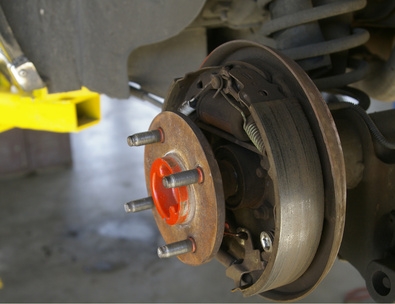
The Grand Am is equipped with self-adjusting drum brakes on the rear wheels. The drums adjust themselves automatically to account for pad wear every time the vehicle backs up. The parking brake also uses the rear drum brakes and is connected by a steel cable. Parking brakes in older cars sometimes stick as rust and dirt build up around the cable. A stuck parking brake will often wear down the drum pads faster than expected.
Loosen the rear wheel nuts with a lug wrench.
Raise the vehicle up with a jack, and lower it onto jack stands. Place blocks on either side of the front wheels so the vehicle will not roll.
Remove the wheel nuts, and pull the wheel off the lugs.
Spray and wash internal drum brake components with brake cleaner, and let them dry. Have a container ready under the brakes to catch the residue from the brake as it drips down. Never use compressed air to blow dust from the brake components.
Pull the adjuster lever away from the center of the wheel, and turn the star wheel to retract the brake shoes from the drum.
Pull on the self-adjuster cable while pushing the adjuster lever toward the back of the vehicle. Unhook the self-adjuster cable from the secondary brake shoe.
Use the spring-removal tool to remove the primary and secondary shoe retracting springs. Remove the self-adjuster cable, and take the anchor pin plate from the anchor pin.
Remove the secondary shoe retracting spring and cable guide from the secondary shoe. Locate the primary shoe hold-down string and pin. Pull the primary shoe and adjusting screw from the backing plate.
Detach the parking brake link. Remove the secondary shoe hold-down spring and pin, and lift the shoe from the backing plate. Use a small screwdriver to pry the parking brake lever retaining clip from the pivot pin. Separate the parking brake lever from the secondary shoe.